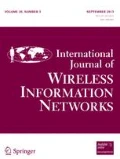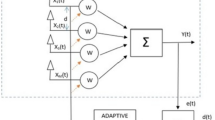Abstract
Early cellular architectures consisted of basestations with omnidirectional antennas. Althoughdirectional antennas are widely used in currentcellular/PCS (Personal Communication System) the systemarchitecture is often still based upon an omnicellstructure, and potential advantages of sectorization arenot fully exploited. This paper analyzes and comparestwo different approaches to sectorization: thetraditional wide-beam trisector cell (WBTC) and the newer(but not well characterized) narrow-beam trisector cell(NBTC). Unlike the WBTC architecture using three100-120° antennas in a base station, the NBTCarchitecture (also called “clover-leaf”) usesthree 60-70° antennas at each base. We have obtainednew results on the quantitative performance of botharchitectures, taking into account the impact of (1)actual (rather than ideal) antenna patterns, (2)channel utilization factor, (3) site diversity, (4)nonideal cell site locations, and (5) the influences ofreuse factor and shadow fading. We show that NBTC system performance exceeds that of WBTC systems, bothin signal-to-interference ratio (SIR) statistics andsignal coverage. The improvement in coverage translatesto a reduced power requirement of about 2 dB for the same cell size, or equivalently, to a 25%larger cell coverage area for the same power. Theimprovement in SIR performance corresponds to a gain of2-3 dB in the 90th SIR percentile. This gain can be translated to significantly improvedgrade-of-service in cellular environments, with noattendant cost.
Similar content being viewed by others
REFERENCES
V. Palestini, Alternative frequency plans in hexagonal-shaped cellular layouts, in IEEE International Symposium on Personal, Indoors, and Mobile Radio Communications, 1992, pp. 585–590.
W. C. Y. Lee, Smaller cells for greater performance, IEEE Communications Magazine, Nov. 1991, pp. 19–23.
Y. S. Yeh and S. C. Schwartz, Outage probability in mobile telephone due to multiple log-normal interferers, IEEE Transactions on Communications, Vol. 32, Apr. 1984, pp. 380–388.
C. Balanis, Antenna Theory.Harper & Row, New York, 1982.
G. C. D. Piazza, A. Plitkins, and G. I. Zysman, The cellular test bed, The Bell System Technical Journal, Vol. 58, Jan. 1979, pp. 215–248.
Product Selection Guide 195, CELWAVE Inc., 1995.
Wireless Communication Antennas Catalog.Radiation Systems Inc., 1995.
M. V. Clark, V. Erceg, and L. J. Greenstein, Reuse efficiency in urban microcellular networks, in IEEE Vehicular Technology Conference, 1996, pp. 421–425.
R. Rudokas and T. Benz, Is it time to rethink frequency reuse formulas? Telephony, Vol. 232, Mar. 1997, pp. 68–74.
S. Ariyavisitakul, T. E. Darcie, L. J. Greenstein, M. P. Phillips, and N. K. Shankaranaraya nan, Performance of simulcast wireless techniques for personal communication systems, IEEE Journal on Selected Areas in Communication, Vol. 14, May 1996, pp. 632–643.
L. C. Wang and C. T. Lea, Macrodiversity cochannel interference analysis, Electronics Letters, Vol. 31, Apr. 1995, pp. 614–616.
Personal communications with J. F. Whitehead, Feb. 1997.
Rights and permissions
About this article
Cite this article
Wang, LC., Chawla, K. & Greenstein, L.J. Performance Studies of Narrow-Beam Trisector Cellular Systems. International Journal of Wireless Information Networks 5, 89–102 (1998). https://doi.org/10.1023/A:1018844800995
Issue Date:
DOI: https://doi.org/10.1023/A:1018844800995




